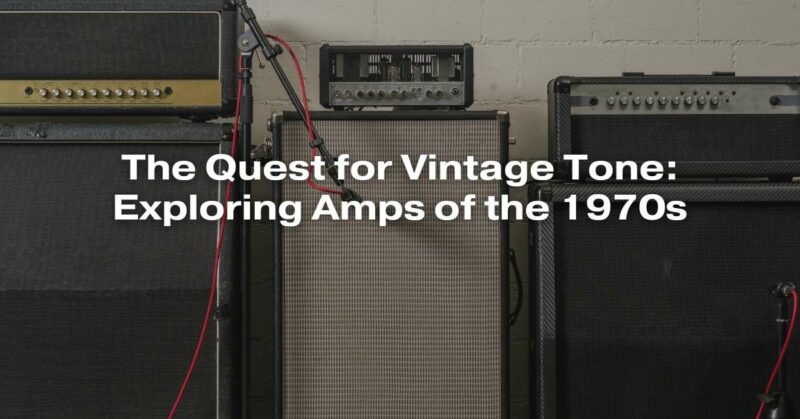The 1970s were a transformative decade for music. This era witnessed the rise of rock ‘n’ roll, the birth of punk, the evolution of jazz fusion, and the emergence of heavy metal. A defining characteristic of the music from this period was its iconic guitar tones, many of which were achieved through amplifiers that are now considered vintage treasures. In this article, we’ll delve into the world of amplifiers from the 1970s and explore why they continue to be sought after by musicians and collectors alike.
The Amplifier Landscape of the 1970s
The 1970s marked a significant shift in amplifier technology. It was a time when tube amplifiers, which had been the industry standard for decades, were gradually being replaced by solid-state amplifiers. However, the ’70s also saw the coexistence of both technologies, leading to a diverse range of amplifiers catering to different musical genres and player preferences.
Tube Amps: The Classic Sound
Tube amplifiers, also known as valve amplifiers, were the hallmark of vintage tone in the 1970s. These amplifiers relied on vacuum tubes to amplify the guitar signal. Brands like Fender, Marshall, and Vox had already established themselves as leaders in the tube amplifier market by this time.
One of the most iconic amplifiers of the ’70s was the Marshall Super Lead 100. Used by legendary guitarists like Jimi Hendrix and Jimmy Page, the Super Lead 100 delivered a searing, overdriven tone that became synonymous with classic rock. Its crunchy distortion and singing sustain were essential ingredients in the era’s guitar-driven music.
Fender, on the other hand, continued to refine its designs from the ’60s, offering amplifiers like the Twin Reverb and Deluxe Reverb. These amps delivered a pristine clean tone that was favored by players exploring jazz, country, and blues.
Solid-State Amps: A New Frontier
While tube amplifiers reigned supreme, the 1970s also saw the emergence of solid-state technology. Brands like Peavey and Roland led the charge in producing solid-state amplifiers. These amps were lighter, more reliable, and often more affordable than their tube counterparts.
One notable solid-state amplifier from the ’70s was the Roland JC-120 Jazz Chorus. This amplifier was a game-changer for clean tones, producing a lush, chorus-drenched sound that became a staple in jazz fusion and new wave music. Its clean, shimmering sound offered a stark contrast to the overdriven tones of tube amps.
The Search for Tone
Musicians in the 1970s were on a constant quest for their signature sound. Many experimented with different amplifiers, effects pedals, and guitar combinations to craft a unique tone that set them apart from the rest. It was a decade of sonic exploration, and amplifiers played a pivotal role in shaping the sound of the era.
Guitarists like David Gilmour of Pink Floyd utilized a combination of tube amplifiers and effects pedals to create the ethereal, ambient tones heard on albums like “Dark Side of the Moon.” His use of Hiwatt and WEM amplifiers, in conjunction with a rotating speaker cabinet, contributed to the band’s iconic soundscapes.
Similarly, Eddie Van Halen’s innovative use of the early solid-state amplifier, the Variac-modified Marshall Super Lead, and homemade effects pedals helped define the sound of Van Halen’s debut album. His “brown sound” was a direct result of his experimentation with different gear combinations.
Why Vintage Amps from the 1970s are Coveted
Fast forward to the present day, and vintage amplifiers from the 1970s remain highly sought after by musicians and collectors. There are several reasons why these amplifiers continue to hold a special place in the hearts of guitarists:
- Tonal Legacy: Vintage amplifiers from the ’70s have a distinct character and tonal quality that is often difficult to replicate with modern equipment. The warmth of tube amps and the unique clean tones of certain solid-state models are timeless.
- Historical Significance: Many iconic albums were recorded with these amplifiers, cementing their place in music history. Owning and playing through the same gear as legendary musicians is a significant draw for collectors and enthusiasts.
- Craftsmanship: Amplifiers from this era were often hand-built with meticulous attention to detail. The quality of components and craftsmanship has contributed to their longevity.
- Nostalgia: For those who grew up in the ’70s, these amplifiers evoke a sense of nostalgia, taking them back to a time when the music of the era was defining their youth.
- Investment: Vintage amplifiers have proven to be valuable investments. The scarcity of well-preserved units has driven up their prices in the collector’s market.
Conclusion
The quest for vintage tone is a never-ending journey for guitarists, and amplifiers from the 1970s are prized for their unique sonic characteristics and historical significance. Whether you’re a seasoned musician looking to capture the spirit of a bygone era or a collector seeking to own a piece of music history, these amplifiers continue to be highly sought after. In a world of ever-evolving technology, the vintage amplifiers of the 1970s stand as timeless icons of tone and creativity, reminding us of the magic of music from that era.


